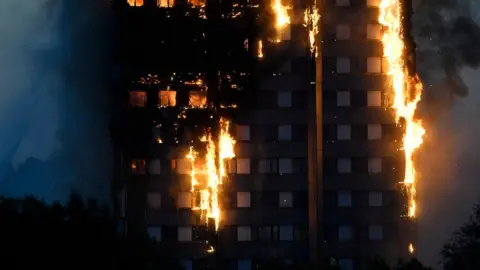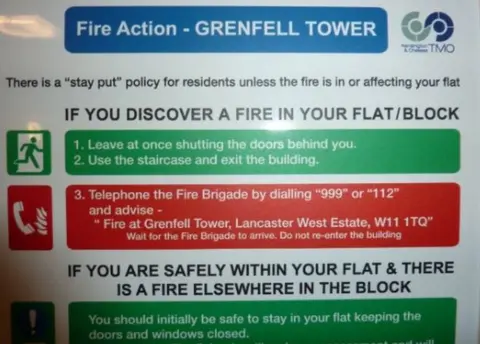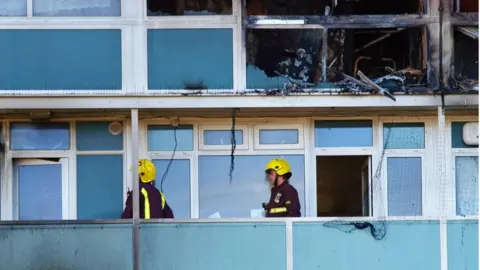Tower block fires: Did government act on advice?
 Reuters
ReutersIn the wake of the disaster at a west London tower block in which 30 people have been confirmed dead so far, there have been accusations that the government has ignored lessons from previous tower block fires.
Could the government have done more?
Over the past few decades, successive governments have made changes to fire regulations for residential premises, to try to reduce deaths. Modern high-rise buildings in England, Scotland and Wales must be fitted with sprinklers, but calls for more to be done to improve safety in older tower blocks increased following major fires in south London in 2009 and in Southampton in 2010.
Following the disastrous fire at Grenfell Tower in west London this week, which quickly engulfed the 24-storey block, the government has been accused of failing to ensure sprinklers were fitted to older blocks and of failing to update building regulations.
Ministers have stressed that at this stage, the exact cause of the Grenfell Tower fire is not known, but Communities Secretary Sajid Javid told the BBC that following such a high number of deaths: "Clearly something has gone disastrously wrong ... something needs to change".
The former Conservative housing minister Mark Prisk told BBC Radio 5live that clearly not enough time had been spent reviewing fire safety in recent years and ministers "need to do more".
What did the Lakanal House coroner recommend?
There has been criticism that warnings were ignored from a coroner's report in March 2013 following a deadly 2009 fire in south London - at Lakanal House in Southwark.
Coroner Frances Kirkham wrote to then Communities Secretary Eric Pickles, flagging up several areas of concern.
She did not say sprinklers must be installed in all high-rise blocks but recommended that the government "encourage" housing providers responsible for high rise flats "to consider the retro-fitting of sprinkler systems".
She said there was "insufficient clarity" on advice given to high-rise residents about what to do in case of a fire - and recommended the government publish new guidance about how advice to "stay put" should be seen in relation to the "get out and stay out" policy.

On building regulations, the coroner said one of the documents - Approved Document B, which relates to fire safety - was "a most difficult document to use" and recommended it be reviewed.
In particular it says the section relating to "external fire spread", regulation B4, should "provide clear guidance" with regard to "the spread of fire" over the outside of a building and whether "attention should be paid to whether proposed [building] work might reduce existing fire protection".
What does Labour say?
Shadow housing secretary John Healey has said the government should "start to act now" on the coroner's report by "installing sprinklers in the high-risk blocks", overhauling the building regulations and "make sure people do have clear advice and information when they live in high-rise blocks like this about what to do when there's a fire".
He has accused the government of having previously "rejected out of hand even encouraging the retrofitting of these sprinkler systems in other high-rise blocks".
Did ministers do nothing?
 Getty Images
Getty ImagesCommunities Secretary Sajid Javid told the BBC "all recommendations were actioned" following the coroner's report.
His predecessor, Sir Eric Pickles, responded to the coroner that he was committed to making the safety of high-rise residents a "priority".
He said "detailed national guidance" had been issued to councils over fire safety advice and about "encouraging" housing providers to "consider" fitting sprinklers to older blocks, following another coroner's recommendation.
On the need to review fire safety building regulations, he said he had "noted" concerns and research had been commissioned which would "feed into a future review" which was expected to result in a new version of regulations to be published in 2016/17.
No new laws were brought in to require landlords to "retro-fit" older high-rises with sprinklers.
What are the laws on sprinklers?
Since 2007 all new tower blocks in England over 30m high must be fitted with sprinklers by law. In Scotland, buildings over 18m high, must be fitted with sprinklers to meet building regulations introduced in 2005. In Wales, all new homes must have sprinklers.
Is it a question of money?
Before the coroner's report, in 2011, the Lib Dem DCLG minister Andrew Stunnell told MPs: "It is the chief fire and rescue adviser's view that it would not be economically viable or practical to fit sprinklers to all existing high-rise residential buildings" and it was up to individual landlords to decide if they were needed.
The British Automatic Fire Sprinkler Association (BAFSA), the trade body for the fire sprinkler industry, said retrofitting Grenfell Tower with sprinklers might have cost £200,000. This is the figure for installing a sprinkler system but does not include potential maintenance fees or costs associated with the wider redevelopment of a building.
Costing will of course vary from building to building. After the Shirley Towers fire in 2010, it cost the council £1m to install sprinklers in three tower blocks.
The cost can be high because in blocks made of concrete and steel like Grenfell, the process is difficult and time-consuming. So the focus has been on other measures which would contain a fire to stop it spreading.
Was a building regulations review "sat on"?
A review of building regulations relating to fire safety was promised in 2016 but has not yet been published.
Then housing minister Gavin Barwell - now Theresa May's chief of staff - said part B of the regulations would be reviewed following the Lakanal House fire.
The DCLG has said it was "simply not true" to suggest ministers had "sat" on the review and work was continuing, after Labour MPs accused the government of kicking the issue "into the long grass".
Ronnie King, the Labour chairman of the all-party parliamentary group on fire safety said the regulations "badly need updating" and "three successive ministers have not done it". He said he believed the government viewed the regulations as "red tape" that would place a burden on business.
What other warnings had there been?
A report to the Home Office in the early 1990s, by the architect Sam Webb reportedly warned that many buildings did not meet basic standards.
A report by the Environment, Transport and Regional Affairs Committee published in 2000 looked at how fire could spread via external cladding systems. It concluded that the evidence did not suggest most cladding posed a serious fire risk but added: "We do not believe that it should take a serious fire in which many people are killed before all reasonable steps are taken towards minimising the risks".
Timeline of other tower block fires
July 2001: One person killed in a 15-storey building in Ramsgate, Kent, after a fire breaks out on the ninth floor
July 2009: Six people, three of them children, killed at 14-storey Lakanal House, Camberwell in south London after a fire caused by a faulty TV
April 2010: Two firefighters die tackling a fire at a 15-storey block of flats
July 2010: A fire at a 15-storey tower block is tackled by about 100 firefighters - no one is killed
November 2011: Two women die in Deptford, south London, at a fire in the 17-storey Mermaid tower block.
January 2012: More than 100 people evacuated from 22-storey block in Swiss Cottage, north-west London, as fire guts the 17th floor
June 2016: A fire spreads from ground floor flat to other flats in 16-storey block in Brixton, south London, dozens of people are moved to safety
August 2016: Faulty tumble dryer is blamed for a fire which damages an 18-storey tower block in Shepherd's Bush, west London
September 2016: Sixty fire fighters sent to 17-storey block of flats in Portsmouth after fire breaks out
